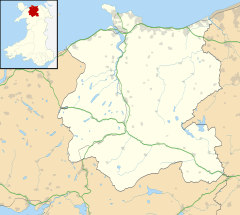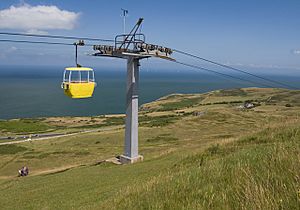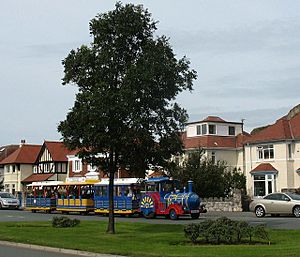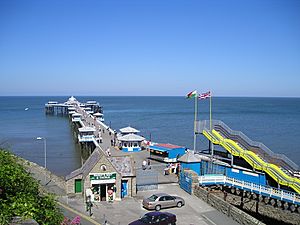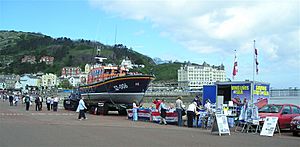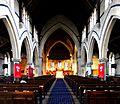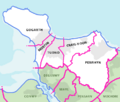Llandudno facts for kids
Quick facts for kids Llandudno |
|
|---|---|
 Llandudno seen from the Great Orme |
|
| Population | 20,701 (2011) |
| OS grid reference | SH783824 |
| Community |
|
| Principal area |
|
| Ceremonial county | |
| Country | Wales |
| Sovereign state | United Kingdom |
| Post town | LLANDUDNO |
| Postcode district | LL30 |
| Dialling code | 01492 |
| Police | North Wales |
| Fire | North Wales |
| Ambulance | Welsh |
| EU Parliament | Wales |
| UK Parliament |
|
| Welsh Assembly |
|
Llandudno is a popular seaside town in Conwy County Borough, Wales. It sits on the Creuddyn Peninsula, which sticks out into the Irish Sea. In 2011, about 20,701 people lived here. The town's name comes from its special saint, Saint Tudno.
Llandudno is the biggest seaside resort in Wales. As early as 1861, people called it 'the Queen of the Welsh Watering Places'. This means it was a very popular holiday spot even back then!
Contents
History of Llandudno
Llandudno grew from very old settlements from the Stone Age, Bronze Age, and Iron Age. These early people lived on the slopes of a big limestone hill called the Great Orme. The first recorded history of the area dates back to 1284. That's when King Edward I gave the land to the Bishop of Bangor.
The Great Orme
The Great Orme is a huge limestone headland that overlooks Llandudno. It's home to several herds of wild Kashmiri goats. These goats originally came from some goats given by Queen Victoria to Lord Mostyn. The top of the Great Orme is 679 feet (207 meters) high.
The Great Orme is a special place for plants and animals. You can find rare species like peregrine falcons here. There's also a type of wild cotoneaster plant that only grows on the Great Orme. Its steep cliffs are perfect for many sea birds to nest. These include cormorants, puffins, and different kinds of gulls.
This amazing headland has many fun things to do. You can ride the Great Orme Tramway or the Llandudno Cable Car. Both take you easily to the top for great views!
How Llandudno Grew
By 1847, Llandudno had about a thousand people. Most men worked in copper mines. Others were fishermen or farmers.
In 1848, an architect named Owen Williams had a great idea. He showed Lord Mostyn plans to turn the marshy land behind Llandudno Bay into a holiday resort. Lord Mostyn loved the idea and worked hard to make it happen. From 1857 to 1877, much of central Llandudno was built under the guidance of George Felton, an architect and surveyor.
Getting Around Llandudno
Llandudno is connected to the North Wales Coast railway line. This line opened in 1848. Llandudno was built as a holiday spot in the Victorian era. A special railway line was opened in 1858 just for Llandudno. It connects to Llandudno Junction and has stops at Deganwy and Llandudno.
You can also get around Llandudno by bus. Arriva Buses Wales offers services to places like Rhyl and Bangor. Llew Jones buses go to Betws-y-coed and Llanrwst.
Trams
Today's Trams
- The Great Orme Tramway takes you to the top of the Great Orme.
Old Trams
An electric tramway used to run between Llandudno and Rhos-on-Sea from 1907. It later went all the way to Colwyn Bay in 1908. This tram service stopped in 1956.
Llandudno Today
Today, Llandudno includes several nearby areas like Craig-y-Don and Penrhyn Bay. Even though some areas are across the River Conwy, they are still part of the Llandudno community.
Fun Things to Do in Llandudno
Llandudno Bay and the North Shore
Llandudno has a beautiful beach of sand and pebbles. It stretches for two miles between the Great Orme and the Little Orme.
Along most of Llandudno's North Shore, there's a wide, curving Victorian promenade. Many of Llandudno's hotels are built along this road. Near the middle of the bay is the Venue Cymru, a large entertainment center.
Llandudno Pier
The famous Llandudno Pier is on the North Shore. It was built in 1878 and is a Grade II listed building. This means it's a special old building that is protected.
The pier was made longer in 1884. It is now the longest pier in Wales, measuring 2,295 feet (700 meters). On the pier, you can find a bar, a cafe, arcades, and shops. In the summer, you might even see Professor Codman's Punch and Judy show near the pier entrance!
Happy Valley
The Happy Valley used to be a quarry. Lord Mostyn gave it to the town in 1887 to celebrate Queen Victoria's Golden Jubilee. It was turned into beautiful gardens with miniature golf courses and an open-air theatre.
In 1969, the Great Orme Cabin Lift opened here. This cable car takes you to the summit of the Great Orme. It's the longest single-stage cabin lift in Britain! The open-air theatre closed in 1985. In 1987, two miniature golf courses were turned into an artificial ski slope and a toboggan run. The gardens were fixed up for the millennium celebrations and are still a popular spot.
Marine Drive
The Marine Drive is a scenic road that goes around the Great Orme. It was first a footpath in 1858 and became a carriage road in 1878. The 4-mile (6.4 km) one-way drive starts near the Happy Valley. Along the way, you can find St. Tudno's Church, the Great Orme Bronze Age Copper Mine, and the Great Orme Lighthouse.
West Shore
The West Shore is a quiet beach on the River Conwy estuary. This is where Alice Liddell, who inspired Alice in Wonderland, spent her summer holidays from 1862 to 1871. It's a peaceful area with a few hotels and homes. The West Shore is connected to the North Shore by a wide road called Gloddaeth Avenue.
Shopping Streets
Behind the promenade are Mostyn Street, Mostyn Broadway, and Mostyn Avenue. These are the main shopping streets in Llandudno. Mostyn Street has many high street shops, banks, and the town's public library.
Victorian Extravaganza
Every May bank holiday weekend, Llandudno holds a three-day Victorian Carnival. Mostyn Street becomes a funfair! There's a parade each day, and a Festival of Transport takes place in the Bodafon Farm fields.
Venue Cymru
The North Wales Theatre, Arena and Conference Centre was built in 1994 and expanded in 2006. It's now called "Venue Cymru". It's located near the middle of the promenade. This venue is famous for its shows, including opera, concerts, ballet, musicals, and pantomimes.
Llandudno Lifeboat
Llandudno has a unique lifeboat station. It's located inland, which means the lifeboat can launch quickly from either the West Shore or the North Shore. Llandudno's volunteer crews are very busy, helping many small boats in the coastal waters. The Llandudno Lifeboat is often on display on the promenade on Sundays and bank holidays from May to October.
Places to Worship
The old parish church of Saint Tudno is located near the northern tip of the Great Orme. It was started by Tudno, a monk from the 6th century. The church you see today dates from the 12th century and is still used for services on summer Sunday mornings.
Llandudno has many Christian churches. These include Holy Trinity Church, the Roman Catholic Church of Our Lady Star of the Sea, and Saint John's Methodist Church. There is also a Jewish center and a Buddhist center in Llandudno.
Special Connections
Llandudno is twinned with the town of Wormhout in France. This connection is because of a sad event during World War II. Many soldiers from Llandudno were captured near Wormhout in 1940.
Llandudno also has a link to World War I. A group of soldiers from North Wales, trained in Llandudno, fought bravely in the Battle of the Somme. They helped capture Mametz Wood. After the war, the people of Llandudno helped raise money to rebuild the village of Mametz.
Famous People and Culture
Llandudno has hosted the Welsh National Eisteddfod several times, which is a big festival of Welsh culture.
Elisabeth of Wied, who was the Queen of Romania and a writer, stayed in Llandudno in 1890. She loved Wales and called it "a beautiful haven of peace." This phrase became the town's official motto.
Many famous people have connections to Llandudno. These include Welsh international footballers like Neville Southall and Joey Jones. Australian ex-Prime Minister Billy Hughes went to school here.
The international art gallery, Oriel Mostyn, is on Vaughan Street. It was built in 1901 to show Lady Augusta Mostyn's art collection. After being used for other things, it became an art gallery again in 1979. It was renamed 'Mostyn' in 2010.
Llandudno also has its own small arts festival called 'LLAWN'. This festival celebrates Llandudno's past through art, architecture, and performances. It happens over three days in late September.
Sports
Llandudno is home to Llandudno F.C., a football club that plays at Maesdu Park. They even played in the Europa League in 2016! There are also other local football teams like Llandudno Albion and Llandudno Amateurs. Football has been played in Llandudno since 1865.
The town also has a rugby club, Llandudno Rugby Club, which started in 1952. You can also find local pool, snooker, and domino tournaments here.
Images for kids
See also
 In Spanish: Llandudno para niños
In Spanish: Llandudno para niños


